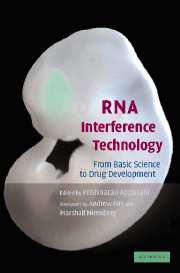Book contents
- Frontmatter
- Contents
- Foreword by Andrew Fire
- Foreword by Marshall Nirenberg
- List of Contributors
- Introduction
- Section one Basic RNAi, siRNA, microRNAs and gene-silencing mechanisms
- Section two Design, synthesis of siRNAs
- Section three Vector development and in vivo, in vitro and in ovo delivery methods
- Section four Gene silencing in model organisms
- Section five Drug target validation
- Section six Therapeutic and drug development
- Section seven High-throughput genome-wide RNAi analysis
- 30 High-throughput RNAi by soaking in Caenorhabtis elegans
- 31 Tools for integrative genomics: Genome-wide RNAi and expression profiling in Drosophila
- 32 Microarray analysis and RNA silencing to determine genes functionally important in mesothelioma
- 33 High-throughput RNA interference
- 34 Generation of highly specific vector-based shRNAi libraries directed against the entire human genome
- Index
- Plate section
- References
31 - Tools for integrative genomics: Genome-wide RNAi and expression profiling in Drosophila
Published online by Cambridge University Press: 31 July 2009
- Frontmatter
- Contents
- Foreword by Andrew Fire
- Foreword by Marshall Nirenberg
- List of Contributors
- Introduction
- Section one Basic RNAi, siRNA, microRNAs and gene-silencing mechanisms
- Section two Design, synthesis of siRNAs
- Section three Vector development and in vivo, in vitro and in ovo delivery methods
- Section four Gene silencing in model organisms
- Section five Drug target validation
- Section six Therapeutic and drug development
- Section seven High-throughput genome-wide RNAi analysis
- 30 High-throughput RNAi by soaking in Caenorhabtis elegans
- 31 Tools for integrative genomics: Genome-wide RNAi and expression profiling in Drosophila
- 32 Microarray analysis and RNA silencing to determine genes functionally important in mesothelioma
- 33 High-throughput RNA interference
- 34 Generation of highly specific vector-based shRNAi libraries directed against the entire human genome
- Index
- Plate section
- References
Summary
Introduction
Recent years have seen the sequencing of the complete genome of human and major model organisms, opening – and demanding – new discovery paradigms. By using a combination of high-throughput methodologies and sophisticated information analysis, several new approaches promise to add function to the raw “sequence” blueprint of life. Currently, high-throughput technologies have been applied to study the transcriptome, by expression profiling (Brown and Botstein, 1999) and ChIP on chip (Wyrick and Young, 2002), the proteome (2D gel-electrophoresis and mass-spectrometry analysis) and protein–protein interactions [(two-hybrid screens, affinity-tag purification coupled with mass-spectrometry, protein chips) (Uetz et al., 2000; Gavin et al., 2002; Drewes and Bouwmeester, 2003; Giot et al., 2003; Li et al., 2004)]. Genome-wide reverse genetic approaches have recently entered the field. In yeast, deletion strains for every gene transcript have been constructed and allow the functional analysis on a genome-wide scale (Wagner et al., 1997; Giaever et al., 2002). Similarly, genome-wide RNAi experiments promise to deliver functional information both in whole-animal assays and focused cell-based screening applications. Typically, hypothesis-driven experiments have relied on combining the strength of different experimental approaches to infer statements about functional properties. It can be similarly expected that in the medium term, a combination of multiple “data-rich” genomic technologies will be required to formulate and test hypotheses about system properties. Ultimately, this should enable us to accurately change physiological systems to prevent or cure disease conditions.
Genome-wide functional screens have become one of the key next challenges to systematically discover gene function.
Information
- Type
- Chapter
- Information
- RNA Interference TechnologyFrom Basic Science to Drug Development, pp. 433 - 446Publisher: Cambridge University PressPrint publication year: 2005
